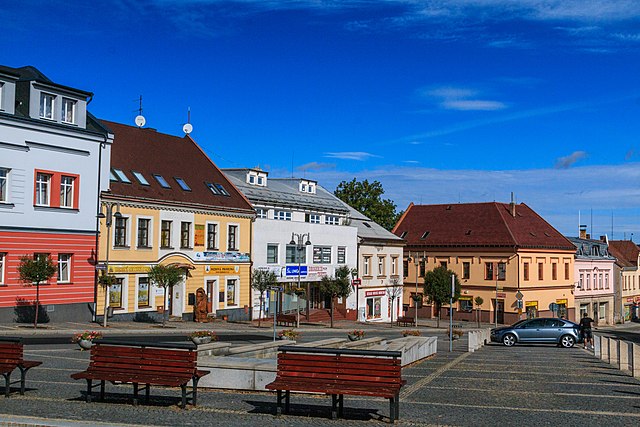Hlinsko
Town in Pardubice, Czech Republic From Wikipedia, the free encyclopedia
Town in Pardubice, Czech Republic From Wikipedia, the free encyclopedia
Hlinsko (Czech pronunciation: [ˈɦlɪnsko]) is a town in Chrudim District in the Pardubice Region of the Czech Republic. It has about 9,600 inhabitants. The local part of Betlém is well preserved example of folk architecture and is protected by law as a village monument reservation.
Hlinsko | |
|---|---|
 Town hall | |
| Coordinates: 49°45′44″N 15°54′27″E | |
| Country | |
| Region | Pardubice |
| District | Chrudim |
| First mentioned | 1349 |
| Government | |
| • Mayor | Miroslav Krčil |
| Area | |
• Total | 24.27 km2 (9.37 sq mi) |
| Elevation | 582 m (1,909 ft) |
| Population (2024-01-01)[1] | |
• Total | 9,577 |
| • Density | 390/km2 (1,000/sq mi) |
| Time zone | UTC+1 (CET) |
| • Summer (DST) | UTC+2 (CEST) |
| Postal code | 539 01 |
| Website | www |

The town parts and villages of Blatno, Čertovina, Chlum, Kouty and Srní are administrative parts of Hlinsko. Chlum forms an exclave of the municipal territory.
The name is derived from hlína, i.e. 'clay'. The name arose thanks to the deposits of high-quality potter's clay.[2]
Hlinsko is located about 21 kilometres (13 mi) south of Chrudim and 30 km (19 mi) south of Pardubice. It lies in the Iron Mountains and partly in the eponymous protected landscape area. The highest point is at 678 m (2,224 ft) above sea level. The town is situated on both banks of the Chrudimka River.
The area around the Chrudimka River is inhabited since the 12th century. Hlinsko was founded in the 12th century as a guarding settlement on the trade route from Bohemia to Moravia. The first written mention of Hlinsko is from 1349. The fortress in Hlinsko is first documented in 1413. In the 16th century, it served as a royal customhouse.[3]
During the reign of Maria Theresa, Hlinsko became a market town, and in 1834, it became a town. During its history, the town's economy consisted mainly of agriculture, pottery, wire-making and weaving. The tradition of pottery craft originated in the 15th century and ended in the 19th century. In 1871, the railway was built and the town was industrialized.[2][3]
There is a major dairy company Mlékárna Hlinsko in the town. The company was founded in 1939, and the production started in 1943.[6]

Hlinsko is the terminus of two railway lines, heading from Pardubice and from Havlíčkův Brod.[7]
Hlinsko and several municipalities in the surrounding area are known for Slavic carnival processions of masks. In 2010, this tradition known as "Shrovetide door-to-door processions and masks in the villages of the Hlinecko area" was included on the UNESCO Intangible Cultural Heritage Lists.[8]


Hlinsko is known for the Betlém Village Monument Reservation with preserved examples of folk architecture. This area around the Chrudimka River consists of valuable timbered and brick houses from the 18th and early 19th centuries. It is part of the Vysočina Open Air Museum.[9]
The historic centre is formed by Poděbradovo Square. The most valuable building are the town hall, Ježdík's House and the old fortress. The town hall was built in 1598 and rebuilt in the Baroque style in 1788–1792. The last reconstructions were made in 1850. Since its foundation, it serves its original purpose. Ježdík's House is a significant house with sgraffito decorations from 1904. The old fortress, called just The Fortress, is the oldest building in Hlinsko.[9]
The Church of the Nativity of the Virgin Mary is located outside the historic centre. The originally Gothic church was rebuilt in the Baroque style in 1730–1745, but the Gothic tower was partly preserved. It has a valuable baptistry from 1628.[2][10]
Seamless Wikipedia browsing. On steroids.
Every time you click a link to Wikipedia, Wiktionary or Wikiquote in your browser's search results, it will show the modern Wikiwand interface.
Wikiwand extension is a five stars, simple, with minimum permission required to keep your browsing private, safe and transparent.